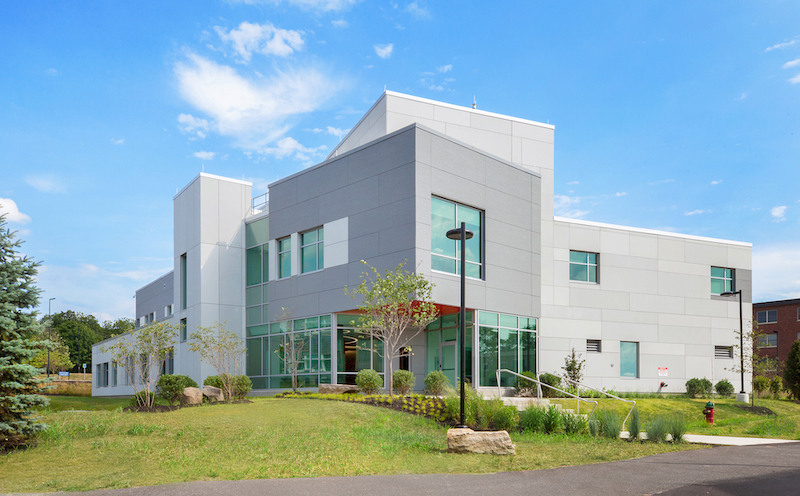The State University of New York (SUNY) at New Paltz’s new Engineering Innovation Hub (EIH) has recently completed construction.
Designed by Urbahn Architects, the two-story EIH was built on a former parking lot on SUNY New Paltz’s main campus. It was designed to allow for a potential expansion to the east if the program requires more space in the future.
The $13.5million, 19,500-sf building houses the College’s bachelor’s degree program in mechanical engineering, teaching and research lab spaces, 3D print prototyping labs, and the school’s Hudson Valley Additive Manufacturing Center (HVAMC).
 Photo by Ola Wilk/Wilk Marketing Communications.
Photo by Ola Wilk/Wilk Marketing Communications.
The HVAMC’s collection of 3D printers are some of the most advanced technology at any academic laboratory in the United States, according to the university. SUNY is the first institution of higher education in the country to be designated a Stratasys-MakerBot Additive Research & Teaching (or SMART) lab by Stratasys, a 3D printing hardware and systems company.
See Also: St. Louis Community College Center for Nursing and Health Sciences opens to students
 Photo by Ola Wilk/Wilk Marketing Communications.
Photo by Ola Wilk/Wilk Marketing Communications.
The building welcomes students via a 661-sf entrance lobby designed to foster collaboration. It features display cabinets for 3D-printed artifacts, counters with computer charging and data outlets, lounge-style seating, and whiteboards. The building’s first floor also features seating niches within the hallways along the windows that integrate with benches, data access, and charging stations. A 1,900-sf teaching lab includes polished-concrete floors and painted steel columns, beams, and a metal deck ceiling. The HVAMC space is located on the first floor across from the teaching lab. An 850-sf machine shop, mechanical and electrical rooms, and public bathrooms round out the first floor.
 Photo by Ola Wilk/Wilk Marketing Communications.
Photo by Ola Wilk/Wilk Marketing Communications.
The second floor is home to a smaller lounge/collaborative space at the end of its main corridor, eight faculty offices, an open office space, a 300-sf conference room, three research/teaching labs, and a 1,200-sf computer lab.
The EIH is centrally located on the SUNY campus and was designed to meet LEED Silver certification requirements.
Also on the Build Team: PC Construction (gc), Vanderweil Engineers (mechanical and electrical engineer), Leslie E. Robertson Associates (structural engineer) BET Engineering Consultants (civil engineer), and Edgewater Design (landscape designer).
 Photo by Ola Wilk/Wilk Marketing Communications.
Photo by Ola Wilk/Wilk Marketing Communications.
 Photo courtesy of SUNY New Paltz.
Photo courtesy of SUNY New Paltz.
Related Stories
University Buildings | May 5, 2023
New health sciences center at St. John’s University will feature geothermal heating, cooling
The recently topped off St. Vincent Health Sciences Center at St. John’s University in New York City will feature impressive green features including geothermal heating and cooling along with an array of rooftop solar panels. The geothermal field consists of 66 wells drilled 499 feet below ground which will help to heat and cool the 70,000 sf structure.
Mass Timber | May 1, 2023
SOM designs mass timber climate solutions center on Governors Island, anchored by Stony Brook University
Governors Island in New York Harbor will be home to a new climate-solutions center called The New York Climate Exchange. Designed by Skidmore, Owings & Merrill (SOM), The Exchange will develop and deploy solutions to the global climate crisis while also acting as a regional hub for the green economy. New York’s Stony Brook University will serve as the center’s anchor institution.
University Buildings | Apr 24, 2023
Solving complicated research questions in interdisciplinary facilities
University and life science project owners should consider the value of more collaborative building methods, close collaboration with end users, and the benefits of partners who can leverage sector-specific knowledge to their advantage.
Green | Apr 21, 2023
Top 10 green building projects for 2023
The Harvard University Science and Engineering Complex in Boston and the Westwood Hills Nature Center in St. Louis are among the AIA COTE Top Ten Awards honorees for 2023.
Higher Education | Apr 13, 2023
Higher education construction costs for 2023
Fresh data from Gordian breaks down the average cost per square foot for a two-story college classroom building across 10 U.S. cities.
Market Data | Apr 11, 2023
Construction crane count reaches all-time high in Q1 2023
Toronto, Seattle, Los Angeles, and Denver top the list of U.S/Canadian cities with the greatest number of fixed cranes on construction sites, according to Rider Levett Bucknall's RLB Crane Index for North America for Q1 2023.
University Buildings | Apr 11, 2023
Supersizing higher education: Tracking the rise of mega buildings on university campuses
Mega buildings on higher education campuses aren’t unusual. But what has been different lately is the sheer number of supersized projects that have been in the works over the last 12–15 months.
Contractors | Apr 10, 2023
What makes prefabrication work? Factors every construction project should consider
There are many factors requiring careful consideration when determining whether a project is a good fit for prefabrication. JE Dunn’s Brian Burkett breaks down the most important considerations.
Smart Buildings | Apr 7, 2023
Carnegie Mellon University's research on advanced building sensors provokes heated controversy
A research project to test next-generation building sensors at Carnegie Mellon University provoked intense debate over the privacy implications of widespread deployment of the devices in a new 90,000-sf building. The light-switch-size devices, capable of measuring 12 types of data including motion and sound, were mounted in more than 300 locations throughout the building.
Architects | Apr 6, 2023
New tool from Perkins&Will will make public health data more accessible to designers and architects
Called PRECEDE, the dashboard is an open-source tool developed by Perkins&Will that draws on federal data to identify and assess community health priorities within the U.S. by location. The firm was recently awarded a $30,000 ASID Foundation Grant to enhance the tool.
















